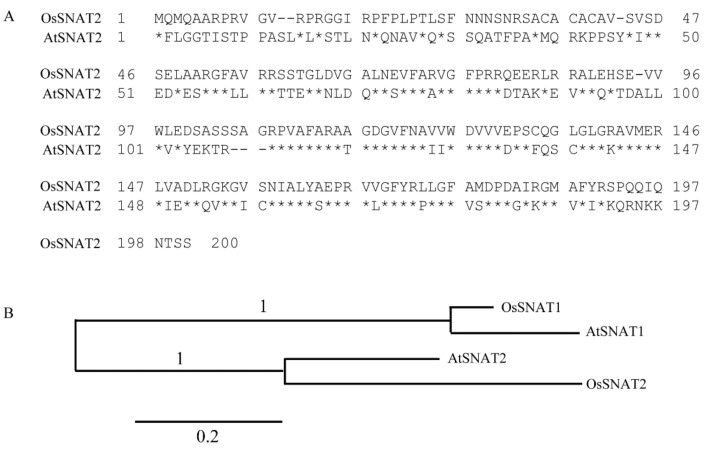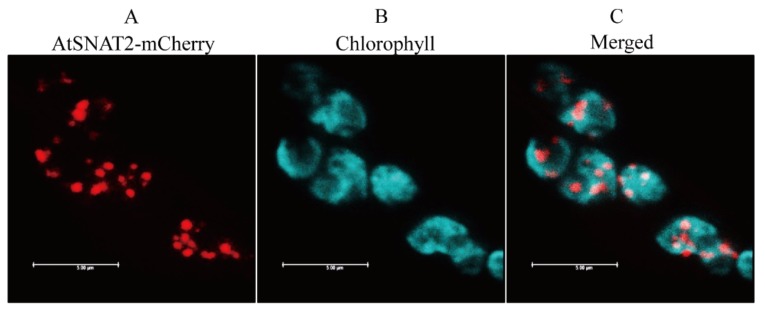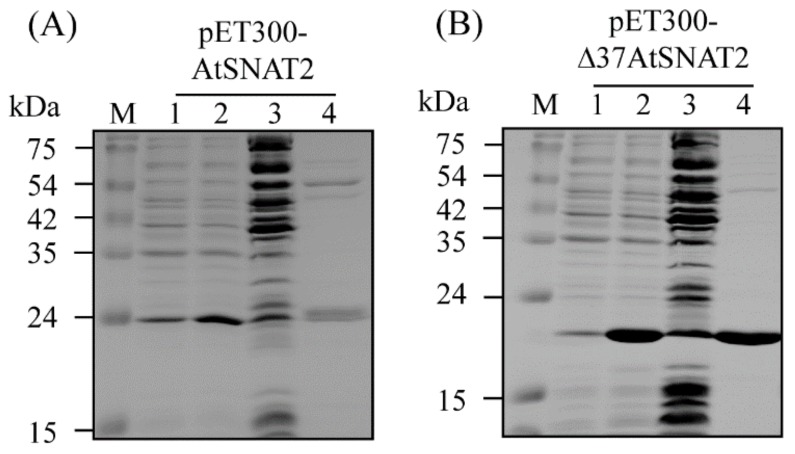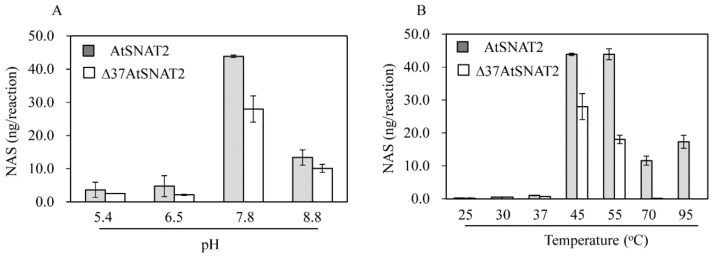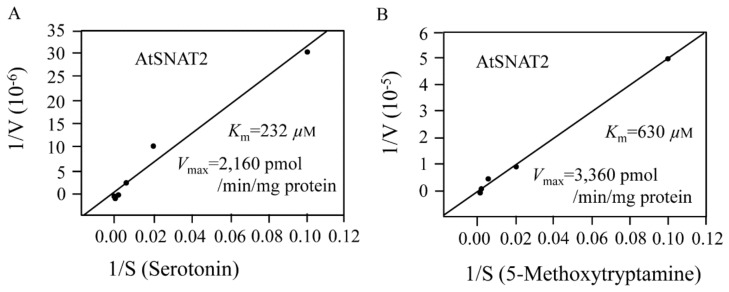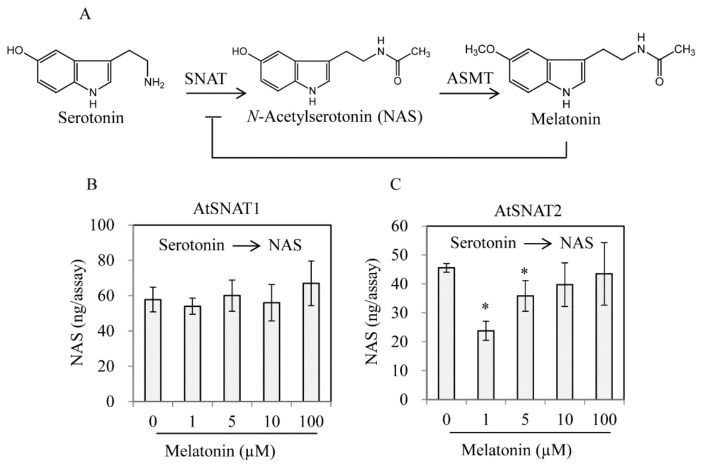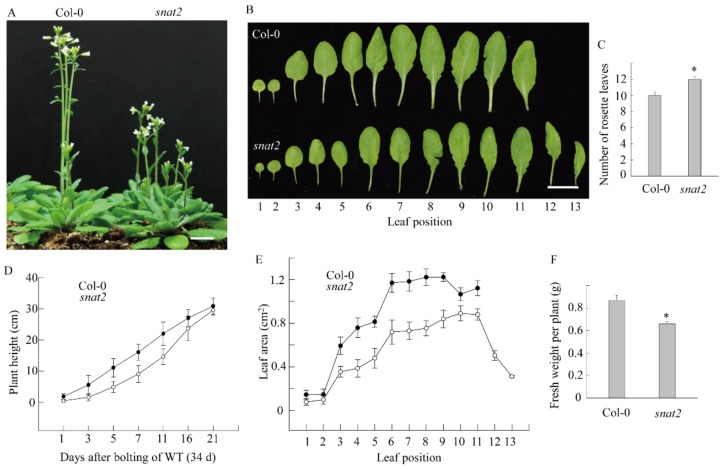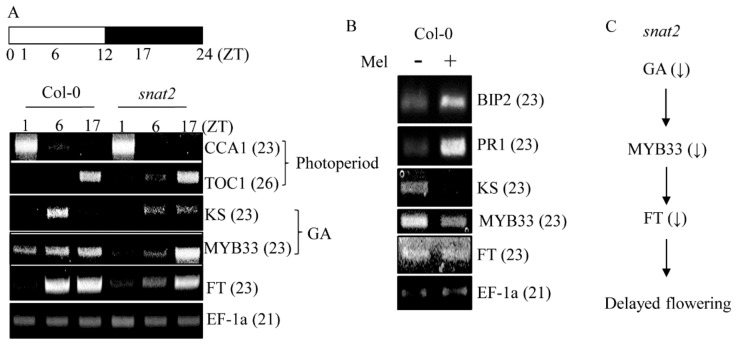Abstract
Melatonin plays roles in both plant growth and defense. Serotonin N-acetyltransferase (SNAT) catalyzes formation of N-acetylserotonin (NAS) from serotonin. Plants contain two SNAT isogenes, which exhibit low-level amino acid homology. We studied the Arabidopsis thaliana SNAT2 (AtSNAT2) gene; we prepared recombinant SNAT2 protein and characterized a snat2 knockout mutant. The SNAT2 protein exhibited 27% amino acid homology with SNAT1; the Km was 232 μM and the Vmax was 2160 pmol/min/mg protein. Melatonin inhibited SNAT enzyme activity in vitro. SNAT2 mRNA was abundantly expressed in flowers; the melatonin content of flowers of the snat2 mutant was significantly less than that of wild-type flowers. The mutant exhibited delayed flowering and reductions in leaf area and biomass compared to the wild type. Delayed flowering was attributable to reductions in the expression levels of the gibberellin biosynthetic genes ent-kaurene synthase (KS) and FLOWERING LOCUS T (FT).
Keywords: Arabidopsis, recombinant SNAT2, flowering, melatonin, snat2 knockout
1. Introduction
The recent identification of an Arabidopsis phytomelatonin receptor implied that melatonin may serve as a plant hormone [1,2]. Melatonin plays many biological roles in plants, being involved in leaf senescence [3], quality control of the endoplasmic reticulum [4], plant growth [5,6], secondary metabolite synthesis [7,8], somatic embryogenesis [9], stomatal closure [1], skotomorphogenesis [10], and leaf development [11]. Melatonin plays roles in plant responses to both biotic and abiotic stressors [12,13,14], mediating tolerance to drought [15], high salt levels [16], high temperatures [17], cold conditions [18], heavy metals [19,20,21,22], and pathogens [23,24].
All plant melatonin biosynthetic genes have been cloned [25]. The genes encoding the last two steps in melatonin biosynthesis are serotonin N-acetyltransferase (SNAT) and N-acetylserotonin O-methyltransferase (ASMT). Plants contain two SNAT isogenes [25]; the rice genome contains three copies of ASMT [26]. SNAT plays important roles in both melatonin function and biosynthesis. Suppression of rice SNAT2 decreased levels of brassinosteroids (plant hormones) and induced a dwarf phenotype, but, suppression of rice SNAT1 did not result in such effects, although melatonin levels were similarly decreased [10]. The in vitro enzyme kinetics of rice SNAT1 and SNAT2 differed [25]. The SNAT1 genes of various plants (and cyanobacteria) have been cloned and characterized [27,28,29], but SNAT2 has been cloned only from rice [30] and grapevine [31].
Although many physiological functions played by melatonin have been reported, there has not been any molecular genetic study on the effect of flowering. Plant flowering is initiated by physical factors such as the photoperiod and vernalization, and by gibberellic acid (GA; a hormone; [32]). The key photoperiod-regulated flowering gene is the night-labile CONSTANT (CO), a zinc finger protein that activates FLOWERING LOCUS T (FT), which in turn promotes floral induction. Vernalization accelerates flowering by decreasing the expression of FLOWERING LOCUS C (FLC), which encodes a MADS-box transcription factor that represses FT. In addition to the above physical factors, GA also directly or indirectly controls FT expression.
Here, we cloned Arabidopsis thaliana SNAT2 and explored the kinetics of the recombinant protein. We investigated an SNAT2 knockout mutant (snat2) in which decreased melatonin levels delayed flowering and retarded growth.
2. Materials and Methods
2.1. Plant Materials and Growth
Arabidopsis thaliana wild-type Col-0 and the knockout snat2 mutant line (SALK_062388) were grown at 22 °C under 60% relative humidity, a 14 h photoperiod, and a photon flux density of 50 µmol m−2 s−1. The Arabidopsis snat2 line (with a T-DNA insert in SALK_062388) was obtained from the Arabidopsis Biological Resource Center (Ohio State University, Columbus, OH, USA). The line was genotyped using the T-DNA express: Arabidopsis gene mapping tool (http://signal.salk.edu/). Tobacco plants (Nicotiana benthamiana) were grown under a 16 h light (28 °C)/8 h dark (22 °C) photoperiod featuring white light (100 μmol photons m−2 s−1). Flowering times were defined by the days to bolting and the numbers of rosette leaves at bolting (n = 20). Leaf area was measured using Fuji ImageJ software [33]. Rosette leaves were photographed adjacent to a ruler; pixels were then converted to metric units. All data were processed with the aid of Microsoft Excel 2010. All experiments were performed in triplicate and were repeated at least three times.
2.2. Homology and Phylogenetic Analysis of AtSNAT2
Amino acid sequence homology was explored with the aid of the BLASTp tool; we interrogated the nonredundant, protein sequence databases of the National Center for Biotechnology Information (http://www.ncbi.nlm.nih.gov/). BLAST-Explorer was used to generate sequence alignments and phylogenetic trees [34].
2.3. Cloning of AtSNAT2 and Purification of Recombinant AtSNAT2 Protein from Escherichia Coli
Total RNA of 3-week-old Arabidopsis leaves was isolated using a NucleoSpin RNA plant kit (Macherey-Nagel, Duren, Germany) and 1 µg thereof was reverse-transcribed using RevertAid transcriptase (Thermo Scientific Fermentas, St. Leon-Ro, Germany) after addition of 500 ng of oligo(dT)18 primer, at 42 °C for 1 h. The cDNA obtained (0.2 µL) served as the template for PCR-based cloning. Reverse transcription (RT)-PCR was employed to clone full-length AtSNAT2 (GenBank accession number BT005218) using the primer pair 5′-AAA AAG CAG GCT CCA TGT TTC TCG GAG GCA-3′ and 5′-AGA AAG CTG GGT TTA TTT CTT GTT TCT CTG-3′. The initial AtSNAT2 PCR product was cloned into the T&A vector (RBC Bioscience, New Taipei City, Taiwan) and the integrity thereof confirmed via sequencing (Bioneer, Daejeon, Korea). Prior to AtSNAT2 expression and purification, the initial RT-PCR product was amplified using a primer pair containing attB recombination sequences (forward primer, 5′-GGG GAC AAG TTT GTA CAA AAA AGC AGG CT-3′; reverse primer, 5′-GGG GAC CAC TTT GTA CAA GAA AGC TGG GT-3′). The resulting AtSNAT2 PCR product was cloned via the Gateway recombination reaction into the pDONR221 vector (Invitrogen, Carlsbad, CA, USA), and then into the destination vector pET300/NT-DEST (Invitrogen). The pET300-AtSNAT2 plasmid was transformed into E. coli strain BL21(DE3) (Invitrogen). An aliquot (10 mL) of an overnight culture grown in the presence of ampicillin (50 mg/L) was inoculated into 100 mL of Terrific Broth [20 g/L Bacto-tryptone, 24 g/L Bacto-yeast extract, glycerol 4 mL/L, and phosphate buffer (0.017 M KH2PO4 and 0.072 M K2HPO4)] containing 50 mg/L ampicillin and incubated at 37 ℃ until the optical density at 600 nm attained 1.0. After addition of isopropyl-β-D-thiogalactopyranoside (IPTG; Sigma, St. Louis, MO, USA) to 1 mM, the culture was grown at 28 ℃ with shaking at 180 rpm for 5 h. The protein was purified via affinity (Ni2+) chromatography according to the recommendations of the kit manufacturer (Qiagen, Tokyo, Japan).
2.4. AtSNAT Enzyme Kinetics
Purified recombinant AtSNAT2 protein was incubated in a final volume of 100 µL with 0.5 mM serotonin or 5-methoxytryptamine (5-MT), and 0.5 mM acetyl-CoA, in 100 mM potassium phosphate (at pH 7.8 or other pH values) at 45 °C (or other temperatures) for 1 h. Reaction products including N-acetylserotonin (NAS) and melatonin were identified with the aid of high-performance liquid chromatography (HPLC). In brief, each reaction was terminated by addition of 20 µL acetic acid and 30 µL methanol and 10 µL aliquots were subjected to reverse-phase HPLC (Waters, Milford, MA, USA) on a SunFire C18 column (Waters; 4.6 × 150 mm) eluted using an isocratic profile of 6% (v/v) methanol for NAS or 10% (v/v) methanol (both in water with 0.3% [v/v] trifluoroacetic acid) at a flow rate of 1 mL/min. Compounds were detected via absorbance at 280 nm. The substrate affinity (Km) and maximum reaction rate (Vmax) were calculated using Lineweaver–Burk plots. Protein concentrations were determined using the Bradford method employing a protein-specific dye (Bio-Rad, Hercules, CA, USA). All analyses were performed in triplicate.
2.5. Subcellular Localization of AtSNAT2
We used the pER-mCherry vector [the kind gift of Dr. H.G. Kang (Texas State University, San Marcos, TX, USA)] to localize the AtSNAT2 protein. Full-length AtSNAT2 was PCR-amplified using a primer set containing AscI sites (GGCGCGCC). The resulting product was cloned into the T&A vector (RBC Bioscience) and the AtSNAT2 insert was digested with AscI and cloned into the AscI site of the binary vector, pER8-mCherry, containing the estrogen-inducible XVE promoter. The pER8-AtSNAT2-mCherry plasmid was transferred into Agrobacterium tumefaciens strain GV2260 using the freeze–thaw method. A confocal microscope (TCS-SP5; Leica, Wetzlar, Germany) was used to evaluate transient within-cell protein expression, as described previously [35].
2.6. Total RNA Isolation and Reverse Transcription/Polymerase Chain Reaction
Total plant RNA was isolated using a NucleoSpin RNA plant kit (Macherey-Nagel, Duren, Germany). Semi-quantitative reverse transcription (RT)-PCR analyses were performed as described previously [21]. The primer sequences used for PCR amplification were as follows: SNAT1 (forward, 5′-GCC AAG GAG ACC GTT AGT GA-3′, reverse, 5′-CTT TGG GTA CCA AAA CAT GCC-3′); SNAT2 (forward, 5′-ATG TTT CTC GGA GGC ACA AT-3′, reverse, 5′-ATT TCT TGT TTC TCT GTT TGC GT-3′); CCA1 (forward, 5′-GTT GCA GCT GCT AGT GCT TG-3′, reverse 5′-CAA AGG CCT CAA AAG AAA AAG A-3′); TOC1 (forward, 5′-TCT CCG GTG ACT TTT GTT GA-3′, reverse 5′-TGG CCA AAT CAG AAC TAG GG-3′); KS (forward, 5′-CCA AGT TGA TCT GGC AGG TA-3′, reverse 5′- TTG TCT CCT AAA ATC AAT TTT CCT C-3′); MYB33 (forward, 5′-TTG TTC TTG GAG CAA CA TGC-3′, reverse 5′-TGC TTG GCA GTT GCT AGT C-3′); FT (forward, 5′-GGT GGA GAA GAC CTC AGG AA-3′, reverse 5′-CTC ATT TTC CTC CCC CTC TC-3′); BIP2 (forward, 5′-GCA GGA GGA GAA TCA TCG AC-3′, reverse 5′-AAA GAG AAC GTC CAG GGA GA-3′); and PR1 (forward, 5′-CTA TAT AAG GAA GTT CAT TT-3′, reverse 5′-CTA TAT AAG GAA GTT CAT TT-3′). EF-1a transcript levels served to normalize all signals (forward, 5′-TGG TGA CGC TGG TAT GGT TA-3′, reverse 5′- CAT CAT TTG GCA CCC TTC TT-3′).
2.7. Melatonin Quantification
Arabidopsis leaves (0.2 g) were ground in liquid nitrogen and thoroughly homogenized in 2 mL chloroform. After centrifugation at 12,000 × g for 10 min, the supernatants were decanted and evaporated to dryness, and the residues were dissolved in 1 mL amounts of methanol; 10 µL aliquots were used for melatonin quantitation via liquid chromatography/dual mass spectrometry (LC-MS/MS; Shimadzu, Kyoto, Japan) as described previously [36]. A mass transition from m/z 233.1 to m/z 174.0 identified melatonin; the retention time was 3.65 min. AB Sciex Analyst software (version 1.5.2) was used for data integration.
2.8. Data Analysis
We used the Student’s t-test of SigmaPlot ver. 10 (Systat Software, Point Richmond, CA, USA). p < 0.05 was considered to indicate statistical significance.
3. Results
3.1. Cloning and Phylogeny of AtSNAT2
SNAT is the penultimate enzyme of the melatonin biosynthetic pathway; plants contain two SNAT isogenes [30]. Plant SNAT1 genes have been relatively well studied [25], but the SNAT2 genes of only rice [10] and grapevine [31] have been evaluated. No plant SNAT2 knockout mutant has yet been investigated. Here, we cloned the rice SNAT2 homolog of Arabidopsis (AtSNAT2). The amino acid sequences of the rice SNAT2 and AtSNAT2 were 48% identical (Figure 1A). Plant SNAT1 and SNAT2 share an amino acid identity level <27%. The two AtSNAT isogenes belong to different clades, implying that they arose via independent evolution rather than gene duplication (Figure 1B).
Figure 1.
Amino acid comparisons among, and the phylogenetic trees of, SNAT isogenes. (A) Predicted amino acid sequences of OsSNAT2 and AtSNAT2. (B) Phylogenetic analyses of rice and Arabidopsis SNAT isogenes. Identity is denoted by stars. Gaps are noted as dashes. Scale bar: substitution value of 0.2/site. Phylogenetic analysis was performed with the aid of BLAST-Explorer (www.phylogeny.fr). The GenBank accession numbers are OsSNAT1 (AK059369), OsSNAT2 (AK068156), AtSNAT1 (At1g32070), and AtSNAT2 (At1g26220; BT005218).
3.2. Subcellular Location of AtSNAT2
To evaluate whether AtSNAT2 is also expressed in chloroplasts, we transiently expressed the AtSNAT2-mCherry fusion protein in tobacco leaves. Figure 2 shows that the protein localized to chloroplasts; the chlorophyll and mCherry fluorescences overlapped precisely. Thus, AtSNAT2 is expressed in chloroplasts, as are other plant SNAT proteins [30,31,35].
Figure 2.
Subcellular localization of AtSNAT2. (A) Red fluorescence of AtSNAT2-mCherry. (B) Cyan fluorescence of chlorophyll. (C) Merged fluorescent images (A+B). Tobacco leaves were infiltrated with Agrobacterium tumefaciens GV2260 expressing the XVG-inducible AtSNAT2-mCherry fusion protein. Bars: 5 μm.
3.3. AtSNAT2 Enzyme Kinetics
We expressed two AtSNAT2 gene constructs in E. coli; the chloroplast-targeting sequence inhibits heterologous protein expression in that bacterium [37]. We thus expressed both full-length AtSNAT2 and an N-terminal-37-amino acid-truncated protein. TargetP analysis predicted the presence of an N-terminal 37-amino acid transit sequence [38]. We purified both recombinant proteins via Ni2+ affinity chromatography; both featured N-terminal hexa-histidine fusions (Figure 3). IPTG enhanced the expression levels of both proteins, but the extent of inducibility and the expression levels of the N-terminal-truncated Δ37AtSNAT2 were greater than those of the full-length protein.
Figure 3.
Affinity purification of AtSNAT2 from Escherichia coli. (A) Purification of the complete AtSNAT2 protein. (B) Purification of the protein lacking the N-terminal 37 amino acids. E. coli BL21 (DE3) cells harboring pET300-AtSNAT2 and pET300-Δ37AtSNAT2 were employed for protein purification. M, molecular mass standards; lane 1, total proteins of 15 µL aliquots of bacterial cultures grown in the absence of IPTG; lane 2, total proteins of 15 µL aliquots of bacterial cultures grown in the presence of IPTG; lane 3, 20 µg of soluble proteins; lane 4, 10 µg of protein purified via affinity chromatography. Protein samples were separated on 12% (w/v) SDS-PAGE gels and stained with Coomassie blue.
The pH and temperature optima in terms of enzymic activity were determined. Figure 4 shows that the total SNAT activity of the full-length protein was greater than that of the truncated protein under all conditions tested. The optimal pH values in terms of activity were pH 7.8 for both proteins, followed by pH 8.8 (Figure 4A). SNAT enzyme activity was 10-fold lower in the pH range pH 5.4–6.5 than at pH 7.8. Optimal SNAT enzyme activity at relatively high pH values is characteristic of other plant SNAT2 enzymes [30,31]. The optimal temperatures for activity were 45 ℃ and 55 ℃ for AtSNAT2, but only 45 ℃ for Δ37AtSNAT2. Surprisingly, AtSNAT2 retained 30% of its peak activity even at 95 ℃; Δ37AtSNAT2 exhibited no activity at that temperature (Figure 4B). Neither the truncated rice nor grape enzyme exhibited any activity at 95 ℃ [30,31]. In contrast, rice Δ83SNAT1 exhibited enzyme activity comparable to that of AtSNAT2 at 95 ℃ [35], implying that plant SNAT enzymes are more thermostable than other melatonin biosynthetic enzymes such as ASMT [35].
Figure 4.
The enzymic activity of recombinant AtSNAT2. (A) The activity at various pH values. (B) The activity at various temperatures. Enzyme activity was measured by assaying N-acetylserotonin (NAS) production by 0.5 μg recombinant protein from 0.5 mM serotonin for 1 h under various conditions.
In assays performed at the optimal pH and temperature, we next determined Km and Vmax values (Figure 5). The Km values for NAS and 5-MT were 232 and 630 μM, respectively. The Vmax values for NAS and 5-MT were 2160 and 3360 pmol/min/mg protein, respectively. The catalytic efficiency (Vmax/Km) for NAS was 9.3 and that for 5-MT was 5.3, indicating that AtSNAT favors NAS synthesis from serotonin rather than melatonin synthesis from 5-MT. The effects of 5-MT on enzyme activity were assessed by measuring the conversion of serotonin to NAS in the presence of 5-MT. Figure 6 shows that NAS production (from 500 μM serotonin) was inhibited by the addition of 50 μM 5-MT, and further fell fourfold when 100 μM of 5-MT was added. The decrease in NAS production was not proportional to the 5-MT concentration. Notably, the NAS and melatonin production levels were similar when the substrate levels were 500 μM, implying that the affinity of SNAT for serotonin and 5-MT is similar when substrate levels are high.
Figure 5.
The Michaelis–Menten kinetics of recombinant AtSNAT2. (A) The Km and Vmax values with serotonin as substrate. (B) The Km and Vmax values with 5-methoxytryptamine (5-MT) as substrate. Km and Vmax values were determined using Lineweaver–Burk plots. The enzymatic products (N-acetylserotonin and melatonin) were assayed using high-performance liquid chromatography (HPLC).
Figure 6.
The effect of 5-MT on SNAT enzyme activity. (A) A schematic of the SNAT enzymic reaction. (B) Inhibition of NAS synthesis by 5-MT. (C) Melatonin production in the presence of serotonin (0.5 mM) and varying levels of 5-MT. All assays were performed in the presence of 0.5 μg AtSNAT2, 0.5 mM serotonin, and various levels of 5-MT. The data are the means of three replicates.
We explored whether AtSNAT1 [28] and AtSNAT2 activity was feedback-regulated by melatonin. Recombinant AtSNAT2 activity was inhibited by addition of 1 μM melatonin to an extent twofold that of the control (Figure 7), but AtSNAT1 activity was not affected by any tested concentration of melatonin, implying that the modes of action of the SNAT isoenzymes differ.
Figure 7.
Effect of melatonin on SNAT enzyme activity. (A) A schematic of the enzymic reaction. (B) Melatonin-mediated inhibition of NAS synthesis by recombinant AtSNAT1. (C) Melatonin-mediated inhibition of NAS synthesis by recombinant AtSNAT2. AtSNAT1 was prepared as described previously [28]. The SNAT enzyme assay was performed in the presence of 0.5 μg AtSNAT2, 0.5 mM serotonin, and various levels of melatonin. The data are the means of three replicates. Asterisks (*) denote significant differences compared to the Col-0 controls (Student’s t-test; p < 0.05).
3.4. AtSNAT2 Expression and the Phenotype of the snat2 Knockout Arabidopsis Mutant
To explore directly whether AtSNAT2 engages in melatonin synthesis and the physiological role played by melatonin, we investigated a T–DNA insertional snat2 knockout mutant (SALK_062388) (Figure 8A). We first measured SNAT1 and SNAT2 transcript levels in various tissues via RT-PCR analysis. SNAT1 mRNA levels were highest in mature leaves; SNAT2 mRNA was abundant in flowers and young leaves; the two isogenes thus exhibited different expression patterns (Figure 8B). RT-PCR of material from one-week-old leaves showed that SNAT2 mRNA was absent in the mutant (Figure 8C). Melatonin levels were 50% lower in flowers of the snat2 mutant than in those of the wild-type Col-0, but the melatonin levels of leaves did not differ, implying that SNAT2 expression is tissue-specific in terms of both mRNA and melatonin synthesis (Figure 8D). In line with this implication, the snat2 mutant exhibited delayed flowering, as evidenced by increased leaf numbers (Figure 9A–C). During bolting, the height of the snat2 mutant was less than that of the wild type, but the mutant attained the wild-type height eventually (Figure 9D). The leaf area of the snat2 mutant was less than that of the wild type, reducing the biomass of the mutant (Figure 9E,F).
Figure 8.
A schematic of Arabidopsis snat2 knockout and SNAT2 mRNA expression. (A) Genomic structure of the Arabidopsis SNAT2 gene (At1g26220). Exons and introns are denoted by solid and open boxes, respectively. The location of the T-DNA insertion is arrowed (not to scale). (B) Tissue-specific expression levels of AtSNAT1 and AtSNAT2 as revealed by RT-PCR. (C) RT-PCR analysis of SNAT2 in wild-type Col-0 and snat2 mutant. (D) Melatonin levels in leaves and flowers. The numbers in parentheses are the PCR cycle numbers. EF-1a served as a loading control, as described previously [4]. An asterisk (*) indicates a significant difference compared to the wild-type Col-0 (Student’s t-test; p < 0.05).
Figure 9.
Delayed flowering of the Arabidopsis snat2 knockout mutant. (A) Phenotypes at flowering. (B) The rosette leaf phenotype. (C) The rosette leaf numbers of the wild-type Col-0 and the snat2 mutant. (D) Stem lengths over time and a comparison of rosette leaf areas. (E) Leaf lengths over time. (F) Biomass values (n = 10). Stem lengths were measured after the wild type commenced bolting (about 34 d after germination). Bars: 1 cm. Asterisks (*) denote significant differences compared to the wild-type Col-0 (Student’s t-test; p < 0.05).
To define the flowering pathway affected by the snat2 mutation, we used RT-PCR to measure gene expression levels. As shown in Figure 10, the expression levels of photoperiod pathway-related flowering genes, including Circadian Clock Associated 1 (CCA1) and Timing of CAB expression 1 (TOC1), were similar in the mutant and wild type over the 24 h day/night cycle (Figure 10A). However, a key gene involved in GA biosynthesis, ent-kaurene synthase (KS), was significantly suppressed, whereas GA-responsive negative transcription factor MYB33 was enhanced in the mutant compared to the wild type, implying that changes in the GA-related pathway (and not the photoperiod pathway) explained the delayed flowering of the snat2 mutant. Reductions in GA synthesis and enhanced MYB33 expression decreased levels of FT florigen, delaying flowering (Figure 10C). We explored whether flowering-related gene expression was affected by exogenous melatonin (1 μM) that infiltrated leaves over 2 h. As shown in Figure 10B, the expression levels of melatonin-induced representative marker genes such as BIP2 and PR1 increased markedly [4], but melatonin suppressed expression of the KS, MYB33, and FT genes, consistent with a previous finding that exogenous melatonin delays flowering [39]. KS, MYB33, and FT suppression by exogenous melatonin was in sharp contrast with such suppression in the snat2 mutant, indicating that exogenous melatonin did not mimic the effects of endogenous melatonin on flowering.
Figure 10.
The daily rhythms of flowering-related gene expression. (A) Daily rhythms of 4-week-old leaves as revealed by RT-PCR. (B) Gene expression levels after addition of exogenous melatonin. (C) A model of delayed flowering in the snat2 mutant. EF-1a served as the loading control. Fully mature leaves of 4-week-old wild-type Col-0 Arabidopsis were infiltrated with 1 μM melatonin and harvested 3 h later. Water served as the control.
4. Discussion
Given the many available Arabidopsis T-DNA knockout mutants, it is simple to explore the roles played by genes of interest [40], including those involved in melatonin metabolism. Melatonin is biosynthesized from tryptophan in four steps catalyzed by tryptophan decarboxylase (TDC), tryptamine 5-hydroxylase (T5H), SNAT, and ASMT [25]. The SNAT-catalyzed reaction is the penultimate step; the SNAT gene family plays pivotal roles in terms of melatonin synthesis regulation in both plants and animals [41]. Rice SNAT1 was first cloned in 2013 [37], followed by SNAT2 [30]; orthologs exist in all plant taxa explored [27,30]. Both SNAT1 and SNAT2 are nucleus-encoded chloroplast proteins involved in melatonin synthesis. It is known that all plant SNAT proteins explored to date were located in chloroplasts [27,30,31,35]. However, single transgenic rice plants differ in terms of phenotype and stress response. Rice plants overexpressing SNAT1 are resistant to abiotic stressors such as senescence [21], while SNAT1 suppression increased the susceptibility of rice plants to cold [42]. However, SNAT2 suppression conferred tolerance to several abiotic stressors, including both cold and heat [43], and was associated with a novel dwarf-like phenotype combined with erect leaves [10]. Thus, the two SNAT isogenes mediate different physiological responses in terms of melatonin synthesis in plants.
Recently, the grape SNAT2 gene was cloned and characterized [31]. The grapevine SNAT2 is 55% identical (in terms of their amino acid sequences) to rice SNAT2. The optimal pH and temperature for grape and rice SNAT2 activity are similar, but the catalytic efficiency (Vmax/Km) of the grape enzyme is less than that of the rice enzyme [30]. Transgenic Arabidopsis overexpressing grape SNAT2 exhibit enhanced melatonin synthesis and increased resistance to powdery mildew (compared to the wild type) [31]. However, no knockout mutant of grape SNAT2 has yet been reported. Our Arabidopsis SNAT2 knockout mutant (snat2) clearly exhibited delayed flowering (Figure 9), as confirmed via molecular genetic analysis. Thus, melatonin affects plant flowering to some extent, but does not delay flowering markedly.
In contrast to the effects of the snat2 mutation, exogenous melatonin retarded Arabidopsis flowering by elevating the level of DELLA protein, the master regulator of GA production, in turn suppressing the expression of flowering genes, including SUPPRESSOR OF OVEREXPRESSION OF CONSTANT 1 (SOC1) and FLOWERING LOCUS T (FT) [39]. These contradictory results are explained by the fact that high-dose melatonin (0.5 mM) retards the growth of Arabidopsis seedlings. The melatonin biosynthetic mutant snat1 also exhibited delayed flowering (data not shown). We are currently studying the snat1 mutant in detail.
We found, for the first time, that SNAT2 was involved in melatonin synthesis in Arabidopsis and was abundantly expressed in flowers. The snat2 mutant produced less melatonin than did the wild type, in turn affecting GA biosynthesis and FT expression, both of which regulate flowering. We suggest that the reduced melatonin levels are associated with less GA synthesis, and compromise FT expression, in turn inhibiting flowering. The mechanism by which melatonin regulates GA synthesis remains to be investigated.
5. Conclusions
Melatonin plays roles in both plant growth and defense. Serotonin N-acetyltransferase (SNAT) catalyzes the formation of N-acetylserotonin (NAS) from serotonin; NAS is then converted to melatonin. Plants contain two SNAT isogenes, which exhibit low-level amino acid homology. SNAT is the penultimate enzyme of melatonin biosynthesis. This is the first study to characterize a snat2 mutant genetically. The mutant exhibited delayed flowering; this is the first genetic indication that melatonin is involved in flowering.
Author Contributions
Conceptualization, K.B.; data curation, H.Y.L. and K.L.; formal analysis, H.Y.L. and K.L.; funding acquisition, K.B.; writing—original draft, K.B.; and writing—review and editing, K.B.
Funding
This research was supported by grants from the Research Fellow Program (NRF-2017R1A6A3A11028333) and the Basic Science Research Program of the National Research Foundation of Korea (2017R1A2A2A05069253) funded by the Ministry of Education, Republic of Korea.
Conflicts of Interest
The authors declare no conflict of interest.
References
- 1.Wei J., Li D.X., Zhang J.R., Shan C., Rengel Z., Song Z.B., Chen Q. Phytomelatonin receptor PMTR1-mediated signaling regulates stomatal closure in Arabidopsis thaliana. J. Pineal Res. 2018;65:e12500. doi: 10.1111/jpi.12500. [DOI] [PubMed] [Google Scholar]
- 2.Arnao M.B., Hernández-Ruiz J. Melatonin: A new plant hormone and/or a plant master regulator? Trends Plant Sci. 2019;24:38–48. doi: 10.1016/j.tplants.2018.10.010. [DOI] [PubMed] [Google Scholar]
- 3.Hong Y., Zhang Y., Sinumporn S., Yu N., Zhan X., Shen X., Chen D., Yu P., Wu W., Liu Q., et al. Premature leaf senescence 3, encoding a methyltransferase, is required for melatonin biosynthesis in rice. Plant J. 2018;95:877–891. doi: 10.1111/tpj.13995. [DOI] [PubMed] [Google Scholar]
- 4.Lee H.Y., Back K. Melatonin plays a pivotal role in conferring tolerance against endoplasmic reticulum stress via mitogen-activated protein kinases and bZIP60 in Arabidopsis thaliana. Melatonin Res. 2018;1:93–107. doi: 10.32794/mr11250006. [DOI] [Google Scholar]
- 5.Chen Z., Gu Q., Yu X., Huang L., Xu S., Wang R., Shen W., Shen W. Hydrogen peroxide acts downstream of melatonin to induce lateral root formation. Ann. Bot. 2018;121:1127–1136. doi: 10.1093/aob/mcx207. [DOI] [PMC free article] [PubMed] [Google Scholar]
- 6.Yang J., Zhang C., Wang Z., Sun S., Zhan R., Zhao Y., Ma B., Ma F., Li M. Melatonin-mediated sugar accumulation and growth inhibition in apple plants involves down-regulation of fructokinase 2 expression and activity. Front. Plant Sci. 2019;10:150. doi: 10.3389/fpls.2019.00150. [DOI] [PMC free article] [PubMed] [Google Scholar]
- 7.Meng J.-F., Xu T.-F., Song C.-Z., Yu Y., Hu F., Zhang L., Zhang Z.-W., Xi Z.-M. Melatonin treatment of pre-veraison grape berries to increase size and synchronicity of berries and modify wine aroma components. Food Chem. 2015;185:27–134. doi: 10.1016/j.foodchem.2015.03.140. [DOI] [PubMed] [Google Scholar]
- 8.Xu L., Yue Q., Bian F., Sun H., Zhai H., Yao Y. Melatonin enhances phenolic accumulation partially via ethylene signaling and resulted in high antioxidant capacity in grape berries. Front. Plant Sci. 2017;8:1426. doi: 10.3389/fpls.2017.01426. [DOI] [PMC free article] [PubMed] [Google Scholar]
- 9.Ramakrishna A., Giridhar P., Jobin M., Paulose C.S., Ravishankar G.A. Indoleamines and calcium enhance somatic embryogenesis in Coffea canephora P ex Fr. Plant Cell Tissue Organ Cult. 2012;108:267–278. doi: 10.1007/s11240-011-0039-z. [DOI] [Google Scholar]
- 10.Hwang O.J., Back K. Melatonin is involved in skotomorphogenesis by regulating brassinosteroid biosynthesis in plants. J. Pineal Res. 2018;65:e12495. doi: 10.1111/jpi.12495. [DOI] [PubMed] [Google Scholar]
- 11.Wang Q., An B., Shi H., Luo H., He C. High concentration of melatonin regulates leaf development by suppressing cell proliferation and endoduplication in Arabidopsis. Int. J. Mol. Sci. 2017;18:991. doi: 10.3390/ijms18050991. [DOI] [PMC free article] [PubMed] [Google Scholar]
- 12.Yu Y., Lv Y., Shi Y., Li T., Chen Y., Zhao D., Zhao Z. The role of phyto-melatonin and related metabolites in response to stress. Molecules. 2018;23:1887. doi: 10.3390/molecules23081887. [DOI] [PMC free article] [PubMed] [Google Scholar]
- 13.Wang Y., Reiter R.J., Chan Z. Phytomelatonin: A universal abiotic stress regulator. J. Exp. Bot. 2018;69:963–974. doi: 10.1093/jxb/erx473. [DOI] [PubMed] [Google Scholar]
- 14.Hernández-Ruiz J., Arnao M.B. Relationship of melatonin and salicylic acid in biotic/abiotic plant stress responses. Agronomy. 2018;8:33. doi: 10.3390/agronomy8040033. [DOI] [Google Scholar]
- 15.Huang B., Chen Y.-E., Zhao Y.-Q., Ding C.-B., Liao J.-Q., Hu C., Zhou L.-J., Zhang Z.-W., Yuan S., Yuan M. Exogenous melatonin alleviates oxidative damages and protects photosystem II in maize seedlings under drought stress. Front. Plant Sci. 2019;10:677. doi: 10.3389/fpls.2019.00677. [DOI] [PMC free article] [PubMed] [Google Scholar]
- 16.Liu D.D., Sun X.S., Liu L., Shi H.D., Chen S.Y., Zhao D.K. Overexpression of the melatonin synthesis-related gene SlCOMT1 improves the resistance of tomato to salt stress. Molecules. 2019;24:1514. doi: 10.3390/molecules24081514. [DOI] [PMC free article] [PubMed] [Google Scholar]
- 17.Ahammed G.J., Xu W., Liu A., Chen S. Endogenous melatonin deficiency aggravates high temperature-induced oxidative stress in Solanum lycopersicum L. Environ. Exp. Bot. 2019;161:303–311. doi: 10.1016/j.envexpbot.2018.06.006. [DOI] [Google Scholar]
- 18.Li X., Wei J.P., Scott E.R., Liu J.W., Guo S., Li Y., Zhang L., Han W.Y. Exogenous melatonin alleviates cold stress by promoting antioxidant defense and redox homeostasis in Camellia sinensis L. Molecules. 2018;23:165. doi: 10.3390/molecules23010165. [DOI] [PMC free article] [PubMed] [Google Scholar]
- 19.Kobylińska A., Reiter R.J., Posmyk M.M. Melatonin protects cultured tobacco cells against lead-induced cell death via inhibition of cytochrome C translocation. Front. Plant Sci. 2017;8:1560. doi: 10.3389/fpls.2017.01560. [DOI] [PMC free article] [PubMed] [Google Scholar]
- 20.Zhang J., Zeng B., Mao Y., Kong X., Wang X., Yang Y., Zhang J., Xu J., Rengel Z., Chen Q. Melatonin alleviates aluminium toxicity through modulating antioxidative enzymes and enhancing organic acid anion exudation in soybean. Funct. Plant Biol. 2017;44:961–968. doi: 10.1071/FP17003. [DOI] [PubMed] [Google Scholar]
- 21.Lee K., Back K. Overexpression of rice serotonin N-acetyltransferase 1 in transgenic rice plants confers resistance to cadmium and senescence and increases grain yield. J. Pineal Res. 2017;62:e12392. doi: 10.1111/jpi.12392. [DOI] [PubMed] [Google Scholar]
- 22.Gu Q., Chen Z., Yu X., Cui W., Pan J., Zhao G., Xu S., Wang R., Shen W. Melatonin confers plant tolerance against cadmium stress via the decrease of cadmium accumulation and reestablishment of microRNA-mediated redox homeostasis. Plant Sci. 2017;261:28–37. doi: 10.1016/j.plantsci.2017.05.001. [DOI] [PubMed] [Google Scholar]
- 23.Wei Y., Hu W., Wang Q., Zeng H., Li X., Yan Y., Reiter R.J., He C., Shi H. Identification, transcriptional and functional analysis of heat-shock protein 90s in banana (Musa acuminate L.) highlight their novel role in melatonin-mediated plant response to Fusarium wilt. J. Pineal Res. 2016;62:e12367. doi: 10.1111/jpi.12367. [DOI] [PubMed] [Google Scholar]
- 24.Zhang S., Zheng X., Reiter R.J., Feng S., Wang Y., Liu S., Jin L., Li Z., Dalta R., Ren M. Melatonin attenuates potato late blight by disrupting cell growth, stress tolerance, fungicide susceptibility and homeostasis of gene expression in Phytophthora infestans. Front. Plant Sci. 2017;8:1993. doi: 10.3389/fpls.2017.01993. [DOI] [PMC free article] [PubMed] [Google Scholar]
- 25.Back K., Tan D.-X., Reiter R.J. Melatonin biosynthesis in plants: Multiple pathways catalyze tryptophan to melatonin in the cytoplasm or chloroplasts. J. Pineal Res. 2016;61:426–437. doi: 10.1111/jpi.12364. [DOI] [PubMed] [Google Scholar]
- 26.Park S., Byeon Y., Back K. Functional analysis of three ASMT gene family members in rice plants. J. Pineal Res. 2013;55:409–415. doi: 10.1111/jpi.12088. [DOI] [PubMed] [Google Scholar]
- 27.Park S., Byeon Y., Lee H.Y., Kim Y.S., Ahn T., Back K. Cloning and characterization of a serotonin N-acetyltransferase from a gymnosperm, loblolly pine (Pinus taeda) J. Pineal Res. 2014;57:348–355. doi: 10.1111/jpi.12174. [DOI] [PubMed] [Google Scholar]
- 28.Lee H.Y., Byeon Y., Lee K., Lee H.J., Back K. Cloning of Arabidopsis serotonin N-acetyltransferase and its role with caffeic acid O-methyltransferase in the biosynthesis of melatonin in vitro despite their different subcellular localization. J. Pineal Res. 2014;57:418–426. doi: 10.1111/jpi.12181. [DOI] [PubMed] [Google Scholar]
- 29.Byeon Y., Lee K., Park Y.I., Park S., Back K. Molecular cloning and functional analysis of serotonin N-acetyltransferase from the cyanobacterium Synechocystis sp. PCC 6803. J. Pineal Res. 2013;55:371–376. doi: 10.1111/jpi.12080. [DOI] [PubMed] [Google Scholar]
- 30.Byeon Y., Lee H.Y., Back K. Cloning and characterization of the serotonin N-acetyltransferase-2 gene (SNAT2) in rice (Oryza sativa) J. Pineal Res. 2016;61:198–207. doi: 10.1111/jpi.12339. [DOI] [PubMed] [Google Scholar]
- 31.Yu Y., Bian L., Jiao Z., Keke Y., Wan Y., Zhang G., Guo D. Molecular cloning and characterization of a grapevine (Vitis vinifera L.) serotonin N-acetyltransferase (VvSNAT2) gene involved in plant defense. BMC Genomics. 2019 doi: 10.1186/s12864-019-6085-3. in press. [DOI] [PMC free article] [PubMed] [Google Scholar]
- 32.Wigge P.A. FT, a mobile developmental signal in plants. Curr. Biol. 2011;21:R374–R378. doi: 10.1016/j.cub.2011.03.038. [DOI] [PubMed] [Google Scholar]
- 33.Schindelin J., Arganda-Carreras I., Frise E., Kaynig V., Longair M., Pietzsch T., Preibisch S., Rueden C., Saalfeld S., Schmid B., et al. Fiji: An open-source platform for biological-image analysis. Nat. Methods. 2012;9:676–682. doi: 10.1038/nmeth.2019. [DOI] [PMC free article] [PubMed] [Google Scholar]
- 34.Dereeper A., Audic S., Claverie J.M., Blanc G. BLAST-EXPLORER helps you building datasets for phylogenetic analysis. BMC Evol. Biol. 2010;10:8. doi: 10.1186/1471-2148-10-8. [DOI] [PMC free article] [PubMed] [Google Scholar]
- 35.Byeon Y., Lee H.Y., Lee K., Park S., Back K. Cellular localization and kinetics of the rice melatonin biosynthetic enzymes SNAT and ASMT. J. Pineal Res. 2014;5:107–114. doi: 10.1111/jpi.12103. [DOI] [PubMed] [Google Scholar]
- 36.Byeon Y., Tan D.-X., Reiter R.J., Back K. Predominance of 2-hydroxymelatonin over melatonin in plants. J. Pineal Res. 2015;59:448–454. doi: 10.1111/jpi.12274. [DOI] [PubMed] [Google Scholar]
- 37.Kang K., Lee K., Park S., Byeon Y., Back K. Molecular cloning of rice serotonin N-acetyltransferase, the penultimate gene in plant melatonin biosynthesis. J. Pineal Res. 2013;55:7–13. doi: 10.1111/jpi.12011. [DOI] [PubMed] [Google Scholar]
- 38.Emanuelsson O., Nielsen H., Brunak S., Heijne G. Predicting subcellular localization of proteins based on their N-terminal amino acid sequence. J. Mol. Biol. 2000;300:1005–1016. doi: 10.1006/jmbi.2000.3903. [DOI] [PubMed] [Google Scholar]
- 39.Shi H., Wei Y., Wang Q., Reiter R.J., He C. Melatonin mediates the stabilization of DELLA proteins to repress the floral transition in Arabidopsis. J. Pineal Res. 2016;60:373–379. doi: 10.1111/jpi.12320. [DOI] [PubMed] [Google Scholar]
- 40.Krysan P.J., Young J.C., Sussman M.R. T-DNA as an insertional mutagen in Arabidopsis. Plant Cell. 1999;11:2283–2290. doi: 10.1105/tpc.11.12.2283. [DOI] [PMC free article] [PubMed] [Google Scholar]
- 41.Tan D.-X., Reiter R.J. Mitochondria: The birth place, battle ground and site of melatonin metabolism in cells. Melatonin Res. 2019;2:44–66. doi: 10.32794/mr11250011. [DOI] [Google Scholar]
- 42.Byeon Y., Back K. Low melatonin production by suppression of either serotonin N-acetyltransferase or N-acetylserotonin methyltransferase in rice causes seedling growth retardation with yield penalty, abiotic stress susceptibility, and enhanced coleoptile growth under anoxic conditions. J. Pineal Res. 2016;60:348–359. doi: 10.1111/jpi.12317. [DOI] [PubMed] [Google Scholar]
- 43.Hwang O.J., Back K. Melatonin deficiency confers tolerance to multiple abiotic stresses in rice via decreased brassinosteroid levels. Int. J. Mol. Sci. 2019;20:5173. doi: 10.3390/ijms20205173. [DOI] [PMC free article] [PubMed] [Google Scholar]



